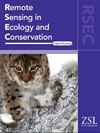陆地和冠层激光扫描综合分析大型古树:对单树和生物多样性研究的启示
IF 4.3
2区 环境科学与生态学
Q1 ECOLOGY
引用次数: 0
摘要
大型古树提供多种生态系统服务,对森林生物量和生物多样性的贡献不成比例。然而,尽管它们的冠层对关键的生态过程(如光拦截、水分调节、碳储存和栖息地形成)具有结构性影响,但它们仍然是被探索最少的陆地栖息地之一。虽然地面激光扫描(TLS)主要从地面捕获树木结构,但它在密集的上层冠层中存在遮挡和精度降低的问题,限制了细尺度树枝和冠层植被的信息。为了解决这个问题,我们引入了冠层激光扫描(CLS)。我们利用脚手架或攀登者将一台高端激光扫描仪送入六棵大古树的树冠。有四种树生长在哥伦比亚、巴西和秘鲁的热带雨林中,它们有大而复杂的树冠和茂密的树叶。在塔斯马尼亚潮湿、温带的桉树林中,两棵“巨树”格外显眼。结合冠层和地面扫描,得到一致的高点云质量。合并后的点云在整个树木中显示出均匀的点密度(降采样至1厘米),从而可以对树木结构及其相关植被进行彻底检查。定量结构模型(QSMs)显示,与TLS相比,估计的树枝体积和长度平均增加了20%,特别是集中在上冠区。我们确定了树的5 × 5 × 5 m3子集的关键附生类群。我们的研究结果表明,CLS提高了点云精度,减少了遮挡,可以更准确地评估树木结构和冠层生物多样性。在可行的情况下,这一进步为微栖息地的三维建模、估算地上碳储量、监测物种和研究生态动态创造了新的机会。本文章由计算机程序翻译,如有差异,请以英文原文为准。
Integrating terrestrial and canopy laser scanning for comprehensive analysis of large old trees: Implications for single tree and biodiversity research
Large old trees provide multiple ecosystem services and contribute disproportionately to forest biomass and biodiversity. Yet their canopies remain among the least‐explored terrestrial habitats, despite their structural influence on key ecological processes such as light interception, moisture regulation, carbon storage and habitat formation. While terrestrial laser scanning (TLS) captures tree structure primarily from the ground, it struggles with occlusion and reduced precision in dense upper canopies, limiting information on fine‐scale branches and canopy vegetation. To address this, we introduce canopy laser scanning (CLS). We lifted a high‐end laser scanner into the canopy of six large, old trees by using scaffolding or climbers. Four trees are in diverse tropical rainforests in Colombia, Brazil and Peru and have large complex crowns with dense foliage. Two ‘giant’ trees stand out in Tasmania's wet, temperate eucalypt forests. Combining canopy and terrestrial scans resulted in a consistent high point cloud quality. The combined point clouds exhibited uniform point densities throughout the entire tree (downsampled to 1 cm), enabling a thorough examination of both the tree structure and its associated vegetation. Quantitative Structure Models (QSMs) showed, on average, a 20% increase (compared to TLS) in estimated branch volume and length, particularly concentrated in the upper crown region. We identified key epiphytic groups for a 5 × 5 × 5 m3 subset of a tree. Our results show that CLS improves point cloud precision and reduces occlusion, enabling more accurate assessments of tree architecture and canopy biodiversity. Where feasible, this advancement creates new opportunities for 3D modelling of microhabitats, estimating aboveground carbon stocks, monitoring species and studying ecological dynamics.
求助全文
通过发布文献求助,成功后即可免费获取论文全文。
去求助
来源期刊

Remote Sensing in Ecology and Conservation
Earth and Planetary Sciences-Computers in Earth Sciences
CiteScore
9.80
自引率
5.50%
发文量
69
审稿时长
18 weeks
期刊介绍:
emote Sensing in Ecology and Conservation provides a forum for rapid, peer-reviewed publication of novel, multidisciplinary research at the interface between remote sensing science and ecology and conservation. The journal prioritizes findings that advance the scientific basis of ecology and conservation, promoting the development of remote-sensing based methods relevant to the management of land use and biological systems at all levels, from populations and species to ecosystems and biomes. The journal defines remote sensing in its broadest sense, including data acquisition by hand-held and fixed ground-based sensors, such as camera traps and acoustic recorders, and sensors on airplanes and satellites. The intended journal’s audience includes ecologists, conservation scientists, policy makers, managers of terrestrial and aquatic systems, remote sensing scientists, and students.
Remote Sensing in Ecology and Conservation is a fully open access journal from Wiley and the Zoological Society of London. Remote sensing has enormous potential as to provide information on the state of, and pressures on, biological diversity and ecosystem services, at multiple spatial and temporal scales. This new publication provides a forum for multidisciplinary research in remote sensing science, ecological research and conservation science.
 求助内容:
求助内容: 应助结果提醒方式:
应助结果提醒方式:


